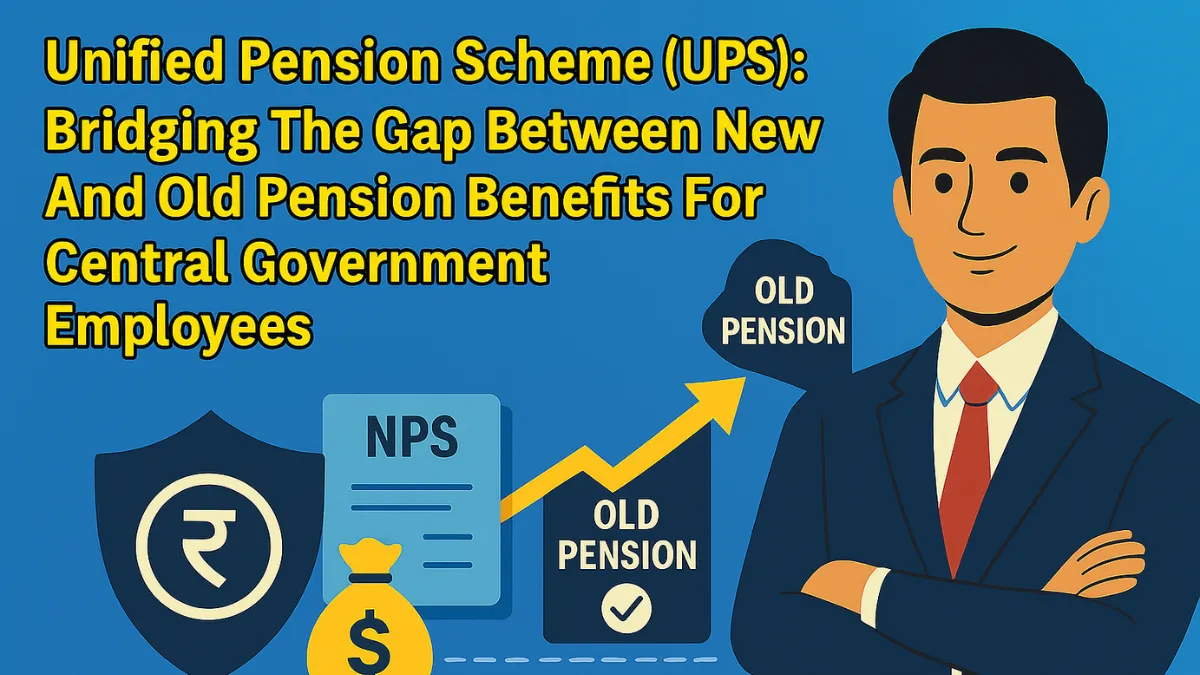The Government of India has introduced a transformative policy move known as the Unified Pension Scheme (UPS), aiming to offer enhanced retirement security to central government employees currently enrolled in the National Pension System (NPS). This scheme has been designed to address long-standing demands from employee groups who have advocated for the return of features found in the Old Pension Scheme (OPS)—most notably, guaranteed monthly pensions and gratuity benefits.
In a landmark development, the UPS offers a hybrid model, effectively bridging the gap between the market-linked NPS and the defined-benefit OPS, providing employees with greater financial stability in retirement.
Understanding the Need for UPS
The shift from OPS to NPS in 2004 was meant to bring financial discipline and reduce pension liabilities. However, the NPS—while allowing for individual pension accounts and investment flexibility—lacked the assurance of guaranteed monthly pensions and gratuity payouts. Many employees felt insecure about their retirement future, especially given the market volatility that affected their pension corpus.
The Unified Pension Scheme (UPS) addresses this critical concern. It creates a system where employees can continue contributing to NPS while being eligible for additional benefits resembling those in OPS, such as a fixed monthly pension and a gratuity component.
Key Features of the Unified Pension Scheme (UPS)
- Fixed Monthly Pension Guarantee:
Retired central government employees under NPS who meet the eligibility criteria will receive a minimum fixed monthly pension, ensuring financial stability regardless of market returns. - Gratuity Benefits:
The scheme restores gratuity payouts for eligible retirees, a major missing element in the NPS framework. This lump-sum payment at retirement helps retirees manage post-retirement expenses. - Eligibility Criteria:
- Employees under the NPS who retired on or before March 31, 2025.
- Must have completed at least 10 years of service under the NPS.
- Applies to central government civil employees; some states may adopt similar models independently.
- Pension Top-Up Option:
If the monthly NPS pension payout is less than what is provided under UPS, retirees can opt for a government-funded top-up, effectively bringing their pension to UPS levels. - Voluntary Opt-In:
The scheme is voluntary, giving eligible retirees and employees the choice to switch based on their preference for financial security versus market-linked growth. - One-Time Opting Window:
Eligible employees must make their choice during the claim window, which was open until June 30, 2025. Extensions may be considered in special cases.
Impact on Central Government Employees
This scheme is a game-changer for thousands of central government employees. By addressing the uncertainty and anxiety surrounding the NPS, the UPS reinforces financial dignity in retirement. Employees who served under NPS for more than a decade now have the opportunity to retire with confidence, knowing they will receive regular, predictable income along with a substantial one-time gratuity.
Moreover, the flexibility of choosing between a lump-sum payout and monthly pension top-ups allows retirees to plan their finances more effectively.
Government’s Perspective and Policy Implications
The UPS reflects a progressive and balanced approach by the Indian government—one that acknowledges fiscal realities while respecting employee demands. It does not completely dismantle the NPS structure, which was introduced to manage pension liabilities sustainably, but rather modifies it to include compassionate benefits found in the OPS.
By offering a hybrid pension architecture, the government ensures long-term viability while restoring the social security net for its workforce.
Challenges and Considerations
While UPS is being celebrated by employee groups, it also raises questions:
- Fiscal Impact: Reintroducing defined benefits may add to the government’s long-term pension burden.
- Uniform Adoption: As of now, this scheme primarily benefits central government employees. States may adopt similar frameworks, but there’s no nationwide mandate yet.
- Awareness and Clarity: Many employees remain unaware of how to calculate the benefits or opt into the scheme. Timely outreach and simplification of procedures are essential.
The Road Ahead
The Unified Pension Scheme (UPS) is a milestone policy that promises to improve the lives of retired central government employees. It strikes a delicate balance between the financial autonomy of the NPS and the security of the OPS. If implemented efficiently and transparently, UPS could serve as a template for future pension reforms—not just in India but globally.
As India moves towards a Viksit Bharat (Developed India) vision by 2047, ensuring the retirement dignity of its public servants is not just a policy decision—it’s a moral commitment.








